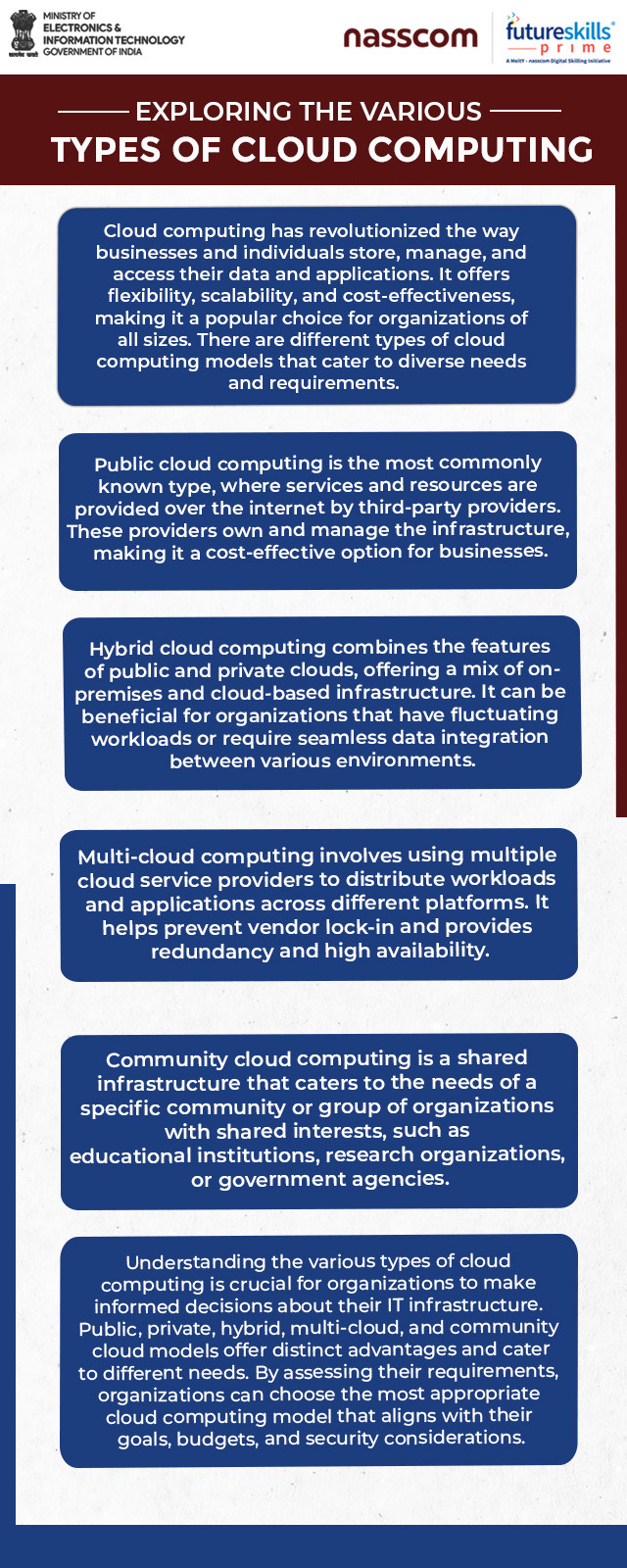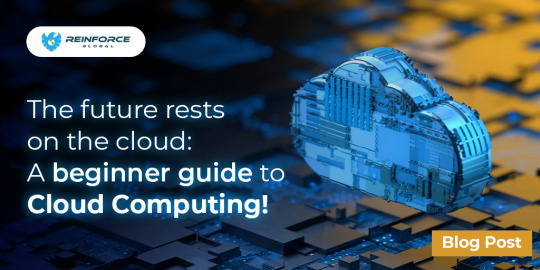#Types of cloud computing
Explore tagged Tumblr posts
Text
Cloud computing delivers services over the internet, allowing users to access and store data remotely. It includes services such as storage, processing power, and software applications. This technology enables scalability, flexibility, and cost-efficiency, transforming how individuals and businesses manage resources and collaborate. Click here to learn more.
0 notes
Text
Best Cloud Solutions Company in Zirakpur - Nextwork Technologies
In today’s rapidly evolving digital world, businesses increasingly rely on cloud services for seamless data management and enhanced operational efficiency. If you’re searching for the best cloud solutions company in Zirakpur, look no further than Nextwork Technologies. Our innovative cloud computing solutions cater to businesses of all sizes, offering secure, scalable, and reliable services designed to meet the growing demands of the digital landscape.
What is Cloud Computing?
Cloud computing refers to the delivery of various computing services—like servers, storage, databases, networking, and software—over the internet (“the cloud”). It allows businesses to access and store data, run applications, and process information without relying on physical infrastructure.
Types of Cloud Computing Services
When choosing a cloud solutions provider, understanding the types of cloud computing services is crucial. There are three primary models:
Infrastructure as a Service (IaaS): Offers virtualized computing resources such as servers, networks, and storage.
Platform as a Service (PaaS): Provides a platform allowing developers to build and deploy applications without managing the underlying infrastructure.
Software as a Service (SaaS): Delivers software applications over the internet, eliminating the need for local installation.
Why Choose Nextwork Technologies?
As the best cloud services provider in Zirakpur, Nextwork Technologies offers a comprehensive suite of cloud solutions that can transform your business operations. Our services are tailored to meet your specific needs, from cloud storage to computing power.
Advantages of Cloud Computing
Partnering with a top cloud solutions company like Nextwork Technologies provides multiple advantages, including:
Cost Efficiency: Reduce IT operational costs by using cloud infrastructure and only paying for what you use.
Scalability: Easily scale up or down your resources based on your business demands.
Security: Our cloud solutions ensure the highest level of security, safeguarding your data from unauthorized access.
Accessibility: Access your data and applications from anywhere, at any time, improving collaboration and productivity.
Backup and Recovery: Ensure data protection with automatic backups and quick disaster recovery options.
Cloud Service Platforms
Cloud computing relies on several leading platforms to offer services. The top platforms we work with include:
Amazon Web Services (AWS)
Microsoft Azure
Google Cloud
IBM Cloud
These platforms are known for their reliability, extensive features, and global reach, making them the backbone of modern cloud computing.
Top Data Center Providers in India
To ensure efficient cloud services, having access to a reliable data center is essential. India is home to some of the world’s top data center companies. These centers play a pivotal role in hosting cloud platforms and ensuring uptime for cloud applications. Here are some of the largest data center operators in India:
CtrlS: Known for operating the country’s largest Tier 4 data center.
Netmagic: A key player providing data hosting and cloud solutions.
Yotta Infrastructure: Hosts one of India’s biggest data centers in Mumbai.
Sify Technologies: Offers robust cloud and data center services.
STT GDC India: Provides data centers across major Indian cities, including Mumbai, Delhi, and Bengaluru.
How Nextwork Technologies Fits Into the Ecosystem
Nextwork Technologies partners with some of these top data centers in India to provide unparalleled cloud solutions. Our cloud infrastructure is hosted on state-of-the-art data centers, ensuring high availability, security, and performance for our clients.
Data Centers in India – The Backbone of Cloud Services
India has seen significant growth in data center infrastructure, with new players entering the market and existing providers expanding their facilities. The country is fast becoming a hub for global cloud service providers due to its growing internet penetration, strong IT industry, and competitive power costs.
If you're seeking India’s biggest data center or looking to collaborate with the best data center companies in India, you’ll want to consider operators like CtrlS, STT GDC, and Netmagic, all of which offer top-tier facilities.
Nextwork Technologies – Your Cloud Partner in Zirakpur
As a leading cloud solutions provider in Zirakpur, Nextwork Technologies delivers unmatched cloud computing services powered by cutting-edge data center technology. We are dedicated to helping businesses move their operations to the cloud with ease, ensuring a smooth transition and long-term success.
Our Services Include:
Cloud Storage: Offering scalable and secure storage solutions for businesses.
Data Backup and Recovery: Ensuring that your business-critical data is protected with real-time backups and recovery options.
Application Hosting: Providing a reliable platform for hosting web applications and databases.
Cloud Consultation: Guiding businesses through their cloud adoption journey by offering expert advice on the best solutions for their needs.
How to Choose the Best Cloud Solutions Company
When choosing the best cloud computing solution in Zirakpur, consider factors like experience, security measures, scalability, and customer support. Nextwork Technologies excels in all these areas, offering a range of services customized to suit your business’s requirements.
Here’s what sets us apart:
Extensive Experience: With over a decade of expertise in cloud computing, we’ve helped numerous businesses transition smoothly to the cloud.
Top-Tier Security: We employ advanced security measures like encryption and multi-factor authentication to protect your data.
Customer Support: Our support team is available 24/7 to assist with any technical issues or questions you may have.
Customizable Plans: Our cloud solutions are flexible, allowing businesses to scale their resources based on real-time needs.
Conclusion: Future-Proof Your Business with Nextwork Technologies
With cloud computing becoming a critical component of modern business, partnering with the best cloud solutions company in Zirakpur is a smart move. Nextwork Technologies is committed to providing world-class cloud services that help businesses grow, innovate, and succeed in a competitive environment. Our solutions are designed to be flexible, secure, and efficient—empowering you to achieve operational excellence.
Whether you’re a small startup or a large enterprise, our cloud services can be tailored to meet your unique business needs. So why wait? Contact us today and take the first step toward a more efficient and scalable future.
#top data center providers in india#types of cloud computing#cloud service platforms#Cloud Computing Solution in Zirakpur
0 notes
Text

Exploring the Various Types of Cloud Computing
Cloud computing has revolutionized the way businesses and individuals store, manage, and access their data and applications. There are different types of cloud computing models that cater to diverse needs and requirements. Know about cloud computing course- https://futureskillsprime.in/Course/google-cloud-computing-foundations-with-kubernetes
0 notes
Text
What is Cloud Computing, and what are the types of cloud computing
Introduction
Well if you are looking for a perfect answer for what is cloud computing and are looking for the types of virtualization in cloud computing then you are at the perfect place. Cloud computing is basically a process of running tasks and applications within a cloud infrastructure. Cloud hosting services use virtualization which divide many physical server into a multiple virtual server. It uses various network of servers to host a website. In cloud computing the data is stored on physical servers which are maintained by a cloud hosting service provider.
How cloud computing works
Cloud computing works by enabling client devices to access data and cloud applications over the internet from remote physical servers, database and computers. An internet network connection links the front end which includes the accessing client, device, network, browser, and cloud software applications. Basically there is a dedicated server in cloud computing for each individual application and workload.
In cloud computing communication between the front end and back end are managed by the central server. And the central server relies on protocol for the exchange of data. Cloud computing mostly relies on virtualization and automation technologies to provide flexible service to the users. Virtualization allows for the easy allocation of resources and cloud system in to various manageable units. So that the user can access and use it easily. In Cloud computing automation and orchestration features are give a ability to the users to easily take control of their resources provisioning, workload deployment and service connectivity without any help of the cloud provider. This unique functionality provides a high degree of flexibility to the cloud users.
As now we have got to know about how does cloud computing works. Lets us now dive into the types of cloud ccmputing.
Types of cloud computing
1. Infrastructure as a service
Infrastructure as a Service (IaaS) is a type of cloud computing that provides users with access to computing resources such as servers, storage, and networking. With IaaS, users can create their own virtual machines on these resources, install their own operating systems, and run their own applications. This means that users do not have to purchase and maintain their own physical servers, but can instead use the resources of a third-party provider to meet their computing needs.
IaaS providers typically offer a range of services, such as virtual machine instances, storage options, load balancing, and network security. Users can choose the resources they need and pay for them on a pay-per-use basis. This allows them to scale their computing resources up or down depending on their changing needs, without having to invest in additional infrastructure.
2. Platform as a service
Platform as a Service (PaaS) is a type of cloud computing that provides users with a platform to develop, run, and manage their own applications, without having to worry about the underlying infrastructure. In PaaS, the provider takes care of the hardware, operating system, and middleware, while the user is responsible for the applications and data.
PaaS offers a more advanced level of abstraction than Infrastructure as a Service (IaaS), because it provides a complete development and deployment platform, rather than just computing resources. This means that users can focus on creating their applications and deploying them to the platform, without having to worry about the underlying infrastructure.
3.Software as a service
Software as a Service is a type of cloud computing where a provider offers access to a complete and functional software application through the internet. This means that users do not need to install anything on their own devices to use the software. Instead, they can access the application through a web browser or a mobile app.
SaaS applications are designed to be easy to use and accessible from anywhere, making them an attractive option for businesses and individuals who need to access software on the go or from different locations. SaaS applications are often offered on a subscription basis, which allows users to pay for the software on a monthly or yearly basis, rather than having to make a large upfront investment.
Conclusion
cloud computing is a powerful technology that is rapidly changing the way organizations think about IT infrastructure and services. By providing on-demand access to a shared pool of computing resources, cloud computing allows organizations to focus on their core business functions while minimizing the cost and complexity of managing their IT infrastructure. However, it is important for organizations to carefully evaluate their cloud computing options and to ensure that they are aware of the risks and trade-offs involved.
0 notes
Text
The future rests on the cloud: a beginner guide to cloud computing

Gone are the days when it was necessary to jack up the memory of your hard drive to fit more files into your system. Technological advancements like cloud computing services have solved this problem entirely. Cloud computing deals with providing a plethora of services via the internet.
If you are reading this informative piece, you are using one of the cloud computing services named Google Docs. As this document is available online, you are free from the hassle of storing it on the hard drive of your PC. Other than Google Docs, there are numerous types of cloud computing services.
We will highlight all the services in this comprehensive piece!
What is Cloud Computing and its Types?
Though we know the general definition of cloud computing, here is a closer look at it!
Cloud computing allows a user or a firm to store resources like documents, presentations, and even software online. It means that whenever you want, you can access the required file from the cloud or the virtual space. This cloud or virtual space is actually a remote server that is connected to the web.
There are various providers in the market that offer remarkable cloud computing services, such as
AWS (Amazon Web Services)
Microsoft Azure
IBM Cloud Services
Google Cloud Platform
ServerSpace
Exploring the Types of Cloud Computing!
So far, we have only talked about storing files like Google Docs. However, cloud computing goes way beyond that. Here are three types of cloud computing!
Type of Cloud Computing
Description
Infrastructure-as-a-service (IaaS)
If you plan to build an app or software, you will need resources like servers, storage, and operating systems. These may cost you a lot if you get them independently, and this is where IaaS comes in.
IaaS provides a user or an organization with all the resources required for IT in one place. Beginning from OS to storage and servers, IaaS encapsulates everything. All these resources are available on an on-demand basis that does not burn a hole in your pocket.
On top of that, the scaling process becomes simpler as you can increase or decrease your spending as per your needs.
Examples: Amazon Web Services, Google Cloud Platform, etc.
Software-as-a-service (SaaS)
This is the most basic form of cloud computing. SaaS enables users to access software and its functionality over the internet. You can use software hosted on the web via a mobile app or web browser.
Some primary examples of SaaS are Netflix, Slack, Dropbox, Gmail, etc.
Platform-as-a-service (PaaS)
Platform-as-a-service model is a complex model that provides users and organizations with services and resources to develop software online. These services can be OS, libraries, programming languages, etc.
Examples: Heroku, Google App Engine, AWS Lambda.
Other than the described ones, there are many other cloud computing services, such as
Big data analytics
Audio and video streaming services
Application testing services
Data storage and backup
Pros and Cons of Cloud Computing Services
Cloud computing also comes with a blend of pros and cons!
Pros of Cloud Computing
As per stats, the market size of cloud computing was $545.8 billion in 2022. Further, it is expected to rise up to $1.2 billion by 2027. These numbers are proof that cloud computing services are in demand and are backed by countless benefits. Here are some of them!
Minimum to Zero Infrastructure Cost
Business organizations have to spend a lot on the IT part of the business. And if the business is of app development, IoT, etc., the cost can be significantly high. For companies like this, cloud computing is a boon.
Rather than purchasing costly servers and software, business owners can opt for cloud computing services at zero infrastructure cost. As per Accenture, businesses choosing cloud computing services like IaaS, PaaS, or SaaS can save 30-40% on the total cost of ownership.
Investment Optimization
If you plan to build an app, you may know how much storage is required by the app. However, what if your estimate goes wrong? You will face losses both ways, whether you invest in infrastructure that is more than required or less. There is no custom resource option here.
With cloud computing, you can invest in a more optimized way. You can choose the only resources that you need. Further, there are various plans for cloud computing services that you can choose based on the necessity of your business. In short, the maximum part of your investment will be spent on using the resources and not on free resources.
You Can Scale Easily and Quickly
Cloud computing services like IaaS, PaaS, SaaS, and more are accessible from anywhere. Moreover, you can invest as per your need, and there is no hassle of maintaining heavy infrastructure from time to time. Therefore, it is easy for you to scale.
If your web app gains users tomorrow or maybe next month, you can purchase more storage space for data and analysis within a few clicks.
Data Backup and Recovery
Cyberattacks are pretty prevalent on the web, and they cost organizations $13 million on average. Hence, it is necessary to go for a solution that offers security against it. Cloud computing services offer you remarkable security features. On top of that, they also offer you auto-backup of data periodically.
Hence, whether you accidentally deleted some data, the hard drive crashed, or a cyberattack affected you, you can recover the data easily.
Automatic Software Updates
Physical IT infrastructure has numerous hardware systems that require updates from time to time which is a task of hassle. On the other hand, the cloud computing infrastructure updates automatically. So, not much hassle here.
Cons of Cloud Computing Services:
There are some drawbacks that may make cloud computing an unfavorable choice.
Downtime
As the entire cloud computing infrastructure is backed by the internet, any disruption can lead to unexpected downtime. Today, businesses cannot afford downtime for a second as they have a lot on the line.
Data vulnerability
As mentioned earlier, the internet forms the backbone of cloud computing services. Therefore, the data is vulnerable to cyberattacks. To ensure security, keep your online data protected using SSL certificates and encryption.
Ongoing costs
Physical IT infrastructure is a one-time investment, though it requires regular maintenance. On the other hand, cloud infrastructure has ongoing costs. You have to pay for the services on a monthly or yearly basis.
Flexibility issues
As there are multiple vendors, it is possible that a person or a firm might want to shift from one vendor to another. In this scenario, cloud platforms can pose a problem due to platform independency and vendor lock-in.
What are the Deployment Models of Cloud Computing Services?
There are three deployment models of cloud computing services!
Public cloud: In this deployment model, regular users can use cloud services to build apps, store data, analyze data, etc. The ideal thing is that it is available on a subscription basis at an affordable price.
Private cloud: This type of cloud computing model is opted for by organizations only due to high capital expenditure. With a higher cost, the private cloud provides state-of-the-art privacy and security issues.
Hybrid cloud: This model blends public and private clouds. It is primarily useful when an organization has to scale quickly or wants to address privacy and security concerns.
Conclusion
Cloud computing has revolutionized the way businesses and individuals store, access, and process data. It offers countless benefits, including but not limited to scalability, cost savings, flexibility, and improved efficiency. It is critical to note that there are pros and cons that you may need to analyze before choosing cloud computing services. If you need professional help regarding the same, you can surely rely on Reinforce Global.
#AWS#cloud computing services#Google cloud platform#IAAS#IBM cloud service#Microsoft Azure#PAAS#SAAS#server space#cloud computing#types of cloud computing#reinforce global
1 note
·
View note
Text
Discover the Fundamentals of Cloud Computing with Cloud Essentials 101
Are you interested in learning about cloud computing but don't know where to start? Look no further than Cloud Essentials 101! This comprehensive guide covers the basics of cloud computing and provides you with a strong foundation to build upon.
In Cloud Essentials 101, you'll learn about the different types of cloud computing, the benefits of cloud computing, and the key concepts and technologies that make it all possible. We'll also cover cloud security and privacy, so you can feel confident in your ability to protect sensitive information in the cloud.
Whether you're just starting out in the tech industry or are a seasoned professional looking to expand your knowledge, Cloud Essentials 101 has something for everyone. With easy-to-understand explanations and practical examples, you'll quickly become an expert in cloud computing.
Don't wait any longer to discover the power of cloud computing. Read Cloud Essentials 101 today and start building your expertise in this exciting and rapidly growing field!
#cloud computing#cloud essentials#fundamentals#basics#types of cloud computing#benefits#key concepts#technologies#cloud security#privacy#tech industry#seasoned professional#easy-to-understand explanations#practical examples#expertise
0 notes
Text


#why do you need this many legs sir#toedscruel#woah holy shit i just looked outside and it's super dark out. i'm queuing this up at noon why is it so dark#lemme look#yeah it's. dark. there's a bunch of dark evil clouds in the sky lookin like it's gonna storm oh i just heard thunder yeah it's gonna storm#uh oh. good thing i'm queueing this guy up before the storm so my power doesn't go out. this happens frequently#anyway toedscruel. it's definitely an evolution of toedscool. it definitely looks like tentacruel#if it's a different pokémon why does it evolve into something so suspiciously similar. i can understand wigglet and wugtrio being#different pokémon. just based on how different they are from diglett and dugtrio. even though their names are a typo away#but this guy is. it. really should've just been a regional form‚ i think#unrelated‚ but on random occasions seemingly whenever someone new finds the blog and reads my tags#i'll occasionally get folks asking me how i type commas in the tags#the answer is that this character → ‚ ← is not a comma. it just looks identical to a comma because of tumblr's font#it's actually a lower quotation mark. so for a language that does ‚this kind’ of quotation marks#and i use it as a comma because i have a fancy linguist keyboard that can type all kinds of fancy symbols. and it's easily accessible#some of my favorites include the single-character ellipse: …#the degrees symbol: º and °#small A: ª#fractions: 1⁄2 2⁄3 1⁄4 etc#and obviously IPA symbols and various diacritics‚ so that i can type the word pokémon without having to copy-and-paste the E#currency symbols‚ too. £¢$§¥ euro is on here somewhere but i don't know where bc i don't use that one really#i just like being able to type things the way they're supposed to be. like it's 80º outside. the stopwatch costs 15¢ in the shop#and‚ of course‚ pokémon. it's the linguistics and computer 'tism combining together i think#it's storming harder now but i found the euro symbol: €#oh fuckin hell my lights just flickered. this is gonna be rough..!
59 notes
·
View notes
Text
I’ve been using macbooks since 2007. Sometime in the 20-teens I started getting refurbished machines with an OS a step or two behind, because I like the older models. I’ve needed a new laptop for months and I was finally ready to upgrade at least a little bit more. (In theory, not monetarily.) So I started doing research. And I’m mad. I’m so mad. First they took away our internal dvd drive and now there’s “apple intelligence.” I hate everything
#my life#my greatest regret is not studying computer science when I could have and keeping up with technology#they don’t build computers for people like me anymore#I need it to run smoothly enough to browse the nightmare that passes for the web these days and word processing and play music and#audiobooks. I need it to run a few very simple special programs. maybe. I want to screen share with my other devices#that’s literally IT why can’t I have that for a reasonable price without all this other shit!!#old woman yells at cloud#(lol the Cloud)#if you have advice please share because typing with my thumbs on this damn phone is going to be the end of me#just don’t suggest windows lol because (bugs bunny rotated dot jpg) No
13 notes
·
View notes
Text









john bomb ( RBLXware ) stimboard for anon i was about to make one of these for myself, thank you for the request ^.^
💙| 💣| 💙 💙| 💙| 💙 💙| 💣| 💙
#stim#stimboard#gif#blue#suit#computer#keyboard#typing#tw hands#cloud#sparkle#john bomb#rblxware#john bomb rblxware#roblox#drink#lava lamp#formal#office
23 notes
·
View notes
Text

i've been manually shading this grass and having sai crash so many times in a row i might be going insane :'D
#my art#wip#at this point i will just leave it like the choppy mess it is rn cause this whole piece feels so.#not ugly or anything- but i know i can do better yfeel me?#i've been glaring at the clouds for 30 minutes trying to fix the colors but nothing woooorks#and my computer is so slow it's actually a chore going on youtube and switching tabs like istg#if you wanna know why i'm not reblogging and posting art it's cause it freezes each time i type a little too fast and it's so frustrating x#begging my poor old computer to just let me switch songs and boom. another crash like- okay.#opening anything feels like trying to defuse a bomb fr gosh >:'D#sorry sorry rant over i'm just tired 😔
41 notes
·
View notes
Text












Recent misc pictures
#image 1 - sky of course.. beautiful clouds time. Image 2 - steak and scrambled eggs with a mushroom spinach sautee sort of thing#and an apple fritter (all cooked at home of course except for the apple fritter... still wishing I could ever get food out or have it made#for me so I don't have to do the effort of making it all myself.. it just tastes better sometimes when you're in a relaxed state eating#it rather than a 'just stood in the kitchen for 1hr' state lol). Image 3 - nice gray clouds with the sun through them.#Image 4 - 4 tiny gyoza type things with a tiny Diet Restriction Friendly size portion of iced coffee and a starshaped ice cube#Images 5 - 7 - these interesting flowers I came across whilst walking on a trail. I think the way they grow is cool. And that the buds of#them are so fluffy and such. Image 8 - 9 -- more stinky word counts... aughhh...... Trying to plan a full timeline of when#I might actually finish the game and I'm estimating currently like July 2025 as an insanely optimistic ideal and October 2025 as my very#late one. So likely somewhere in between. Or even later if something happens as things tend to do (computer explodes. etc)#Both are HOT months for oregon so I guess that's what started me off thinking and dwelling on the passage of time and the weather.. grrr#I wish I could be done with it tomorrow or something and then just relax and play sims all winter knowing my work is done lol#But I feel like the impending summer (as well as many other impending societally threatening things) give me too much urgency to be like#WAUGh i need to get this done NOWWW.. But I still wish I could relax and enjoy the winter a litttle. eugh... ANYWAY. I did finish the#discord for the game but I still don't know if I'll use that. I need to work more on the game itself and the itch.io page. But then also#I should probably talk about it or try to cultivate a small base of people (like a discord) who actually care about it and could become#future playtesters so I have that all ready well before the game actually is done so I needn't scramble at the last minute.. If I were#smart. and had social skills. and had energy (< has none of these things). So inevitably who knows if shall be able to muster any such feat#At least I'm getting like.. some words done.. some days. I am making progress. It's just never good enough considering the circumstances#(< looming instability and time passing in what feels like a very fast manner). ANYWAY.. lol... Image 10 - recent game of Price#Is Right Plinko Pegs my beloved game which I return to to play like maybe 2 rounds of once every 5 months... one day I shall win... Though#I'm incresingly uncertain if there even IS a last level. Or if its designed to go on forever/make you fail at a point to keep you playing..#Last two images - CLOUDS again. A very cloud heavy photo diary this time it seems lol#Also trying to: - post a few more costumes from drafts. - make new friend survey thing. - edit videos - make a sculpture. - set up#things to actually sell sculptures. - doctors appointments. - pack up things to possibly move before the summer to an apartment which#will still not have central AC but maybe at least is not west facing (so gets direct sun hottest part of the day and is a greenhouse)#Life is a constant revolving to do list with occasional sleep & looking at clouds in between.. (sigh)(pauses)(slightly more whimsical sigh)#photo diary
4 notes
·
View notes
Text
Top Data Center and Cloud Solutions Providers in India: Insights on Nextwork Technologies and Cloud Services in Zirakpur
India’s rapid technological growth has fueled the rise of data centers and cloud service providers across the country. For businesses seeking reliable infrastructure, data centers in India are evolving to meet the demands of digital transformation. This blog highlights some of the best data center companies, including Nextwork Technologies, India’s biggest data center, and explores the best cloud computing solutions in Zirakpur.
Overview of Data Centers in India
As the demand for digital storage and computing power surges, data center companies in India have taken center stage. From global companies to local providers, India offers a wide variety of options.
India’s biggest data center is located in Mumbai, managed by Yotta Infrastructure. Spread across 820,000 square feet, Yotta NM1 stands as one of Asia’s largest, boasting robust security features, scalable infrastructure, and advanced technology to support enterprises’ needs. Many other data center companies in India also offer state-of-the-art facilities, catering to various business needs.
Top Data Center Companies in India
Nextwork Technologies Headquartered in Mumbai, Nextwork Technologies is a rising player in the Indian data center market. They are known for their reliable and scalable solutions for businesses of all sizes. Whether it’s providing uninterrupted connectivity or offering secure storage, they’re a go-to for enterprises looking for quality service.
CtrlS Data Centers With a focus on enterprise solutions, CtrlS is another key player. Known for its hyper-scalable data centers, CtrlS offers Tier-4 certified data centers that ensure 99.995% uptime.
ST Telemedia Global Data Centres India (STT GDC India) STT GDC India provides scalable and high-performance data centers to businesses across various industries. They operate several data centers in strategic locations across the country.
NTT Ltd. NTT is a global leader with a strong footprint in India. The company’s data centers offer reliable and secure solutions for businesses looking to store and manage critical data.
These companies are setting the benchmark for innovation, reliability, and security in the data center industry in India.
Best Cloud Solutions in Zirakpur
If you are based in Zirakpur or nearby, you will find plenty of options for cloud computing solutions. Companies offering cloud solutions in Zirakpur are trusted by businesses looking to scale their operations without needing physical IT infrastructure.
What Is Cloud Computing?
Cloud computing allows businesses to access IT resources over the internet rather than maintaining physical infrastructure. It offers flexibility, scalability, and cost savings, which are vital for businesses aiming to stay competitive. Whether it’s hosting websites, storing data, or deploying applications, cloud computing provides a range of solutions.
Types of Cloud Computing
There are different types of cloud computing, each serving distinct needs:
Public Cloud In a public cloud, services are delivered over the internet by third-party providers. Businesses share the same infrastructure, but data remains isolated.
Private Cloud A private cloud is exclusive to a single organization, providing more control and security. This model is often chosen by companies with strict compliance requirements.
Hybrid Cloud The hybrid cloud combines elements of both public and private cloud, allowing businesses to take advantage of both models’ benefits.
These models cater to different business needs and are critical components of cloud service platforms.
Cloud Service Platforms
Several cloud service platforms are available for businesses:
Amazon Web Services (AWS) AWS is a popular cloud service provider offering a variety of services, from computing power to storage and databases.
Microsoft Azure Azure provides a robust platform for application development and enterprise needs, making it a strong contender in the cloud services market.
Google Cloud Platform (GCP) Known for its innovative services, GCP is ideal for businesses seeking scalable, global solutions.
By choosing the right platform, businesses can effectively manage their infrastructure and optimize costs.
Types of Cloud Computing Service Models
Cloud computing offers three main service models:
Infrastructure as a Service (IaaS) IaaS provides virtualized computing resources over the internet, allowing businesses to rent servers and storage as needed.
Platform as a Service (PaaS) PaaS provides a platform that allows businesses to develop, run, and manage applications without worrying about the underlying infrastructure.
Software as a Service (SaaS) SaaS delivers software applications over the internet on a subscription basis. Examples include Google Workspace, Dropbox, and Salesforce.
Advantages of Cloud Computing
Cloud computing offers numerous benefits, including:
Cost Efficiency With cloud services, companies can avoid the high costs associated with purchasing and maintaining physical infrastructure.
Scalability Businesses can scale their resources up or down based on demand, making cloud computing flexible.
Accessibility Cloud services can be accessed from anywhere, making it easier for teams to collaborate remotely.
Data Security Many cloud service providers offer top-notch security features, including data encryption and multi-factor authentication.
Why Choose Nextwork Technologies for Cloud Services?
Nextwork Technologies excels not only in data center services but also in cloud computing solutions. Their infrastructure is designed for businesses looking to expand operations without investing heavily in physical hardware. They offer cloud services that are scalable, secure, and easy to integrate into existing business processes.
For businesses in Zirakpur, Nextwork Technologies provides best cloud solutions, offering everything from IaaS to SaaS. Their cloud infrastructure ensures businesses can access data and applications securely from anywhere, improving efficiency and collaboration.
Conclusion
India is home to some of the most advanced data centers and cloud service providers globally. Whether you’re looking for the biggest data center in India, top cloud computing solutions in Zirakpur, or reliable cloud service platforms, companies like Nextwork Technologies and others are setting new standards in the industry.
Understanding the types of cloud computing and the advantages of cloud computing can help businesses make informed decisions. From enhancing scalability to improving cost efficiency, these solutions are indispensable for the modern business landscape.
If you’re in Zirakpur, consider working with Nextwork Technologies for your cloud computing and data center needs. With cutting-edge infrastructure, they are well-equipped to handle all your business IT needs.
#Best Cloud Solutions Company in Zirakpur#types of cloud computing#top data center providers in india#data center companies in india#Data Centers in India?
0 notes
Text
making icons was a shot in the foot to my business strategy of posting all my replies from work and then lying about doing more when i get home.
#when i typed this post i spelled icons like eye cons? EYE CONS???????? HELLO? i need to do my job.#i cant save stuff to my work computer and im not uploading that shit to a secondary location i dont believe in tha cloud#certified cowboy enjoyer. ↠ ooc.
2 notes
·
View notes
Text
it seems like every 6 months there's some new panic on my dash about google docs' TOS and also every 6 months I'm confused about why so many people still use google docs. I thought this was the "fuck google chrome, switch to Firefox" website so where is the same enthusiasm for word processing alternatives. please love yourselves and download libreoffice or something
#i can't have a high horse about this as i type this on my google phone#but I've never used google docs just bc i don't like it so It's not familiar to me#so i don't understand the attachment to it#also I don't like web apps. documents belong on my computer not a cloud#i mean mine are backed up to a dropbox but that's not where they live. you understand#reilly.txt
1 note
·
View note
Text
One thing I'll give ppl who save stuff online is that it would be nice to read my unposted stuff when I'm away from my computer
#i prefer not to type fic on my phone if i can help it#it just feels too small and cluttered#ill do it to help writers block or if im away and i really wanna write smth down before i forget#and some oneshots feel more appropriate to write on my phone and cozy in bed#but overall like 80% of my shit is written on my computer#and like call me a boomer but i do not trust the cloud to save shit#also i dont like needing an internet connection to work on stuff#tho thats leftover from having shiternet growing up in the middle of nowhere#but it would be nice to reread stuff ive written but havent posted yet on my phone#oh well#enjoy my midnight ramblings
1 note
·
View note